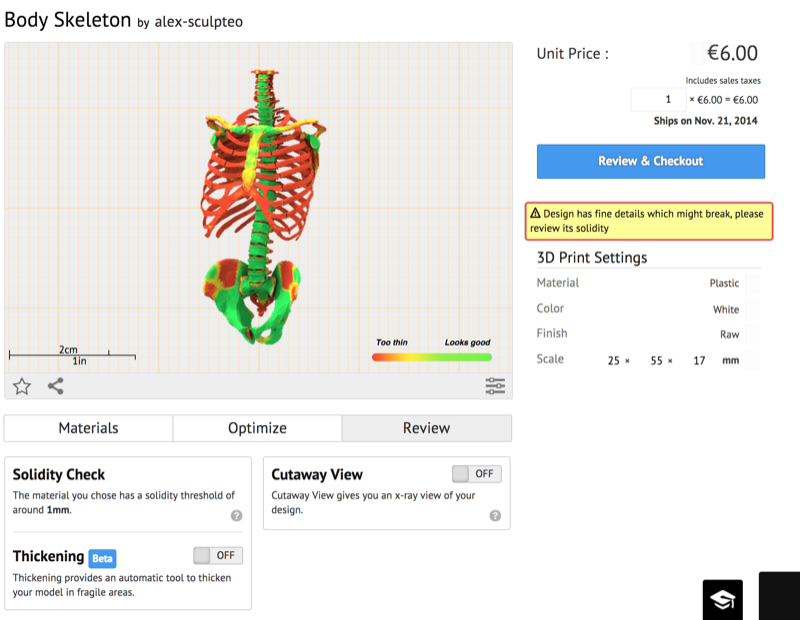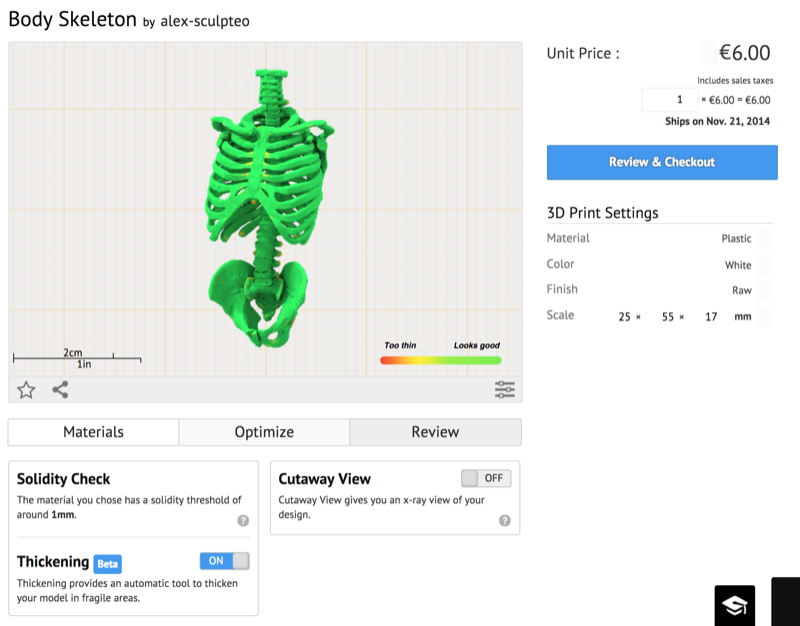If you’ve ever gone to 3D print a model you’ve spent hours working on, designing, refining, perfecting, only to find that the print is too thin in some areas, then Sculpteo has a solution for you. Paris-based community platform and 3D printing service Sculpteo has created an online Thickening Tool that lets you fix your 3D models for free.

Note the “Thickening” box; move the swtich from “Off” to “On” and let the Thickening Tool modify the areas in red and orange that are too thin to print.
Sometimes a delicate or detailed 3D design is difficult to realize in actual 3D printed form, largely due to the limitations of standard filament, which, when too thin, can be quite fragile. Now you can go online to Sculpteo, upload your .stl- or .obj-format file, and then follow these easy instructions to refine your model where it needs to be thicker:
Step 1: Upload your file on the Sculpteo site and then go to the design’s “Review” section.
Step 2: Look for portions of the design that are red and orange (the thinnest are red). These are the areas that require thickening or they will be too thin to print successfully. You will very likely be shown a message that reads, “Design has fine details which might break, please review its solidity.”

The Thickening Tool has completed its work and the modified 3D model can be checked for any problems before printing.
Step 3: At the bottom of the screen, you’ll see a box that is labeled “Thickening.” Move the switch from “Off” to “On” and watch the program begin making the corrections for you, thickening the portions that are too thin to print properly.
Step 4: When the Thickening Tool has completed its task, you will notice that your entire model will have turned from red to green. This indicates that your 3D model is now printable with the minimal amount of alteration of your original design. At this point, you will receive a price for printing and will be given the option to “Review” and “Checkout.”
You are probably wondering how Sculpteo’s new Thickening Tool works, right? Rather than inflating the existing geometry of your 3D model, which would typically result in distortion to varying degrees, Sculpteo’s Thickening Tool creates a new mesh that envelops your design. The creators of the Thickening Tool found that this was the most effective way to preserve the integrity of the original design in most instances. Note, however, that by using the Thickening Tool, you are modifying your 3D design, so be sure to confirm in the viewer that multi-color designs have not been distorted in the process.
The Sculpteo team printed a few different objects to help illustrate the step-by-step process of using their new Thickening Tool. The example seen here of a tiny, partial human skeleton appears in English but the other two examples, including screen shots, are in French, including the 3D model of the famous Parisian landmark, Notre Dame of Paris. If you run into problems or cannot quite work out how to use the Thickening Tool to your benefit, the Sculpteo help staff are happy to assist.
Let us know your thoughts on this new tool in the Sculpteo Thickening Tool forum tread on 3DPB.com.
Subscribe to Our Email Newsletter
Stay up-to-date on all the latest news from the 3D printing industry and receive information and offers from third party vendors.
Print Services
Upload your 3D Models and get them printed quickly and efficiently.
You May Also Like
Metal Powder Supplier Elementum 3D Added to $46B Air Force Contract
Elementum 3D, a Colorado-based developer and supplier of metal powders used in additive manufacturing (AM), announced that the company has been added to the vendors list in the fourth on-ramp...
Ursa Major Lands $28.6M AFRL Deal for 3D Printed Draper Engine Flight Demo
The US Air Force Research Laboratory’s (AFRL’s) Rocket Propulsion Division at Edwards Air Force Base has awarded a $28.6 million contract to Ursa Major for follow-on work related to the...
3D Printing Financials: Rocket Lab’s Record-Breaking Year and Over 20 Launches Coming in 2025
Rocket Lab (Nasdaq: RKLB) closed 2024 with its best year yet. The company launched more rockets, signed more contracts, and expanded deeper into spacecraft and satellite production than ever before....
US Air Force Taps Beehive to Study 3D Printed Jet Engines
Propulsion 3D printing firm Beehive Industries secured a contract from the U.S. Air Force Life Cycle Management Center through SOSSEC. SOSSEC is a company that manages Other Transactions Authority (OTA)...


































